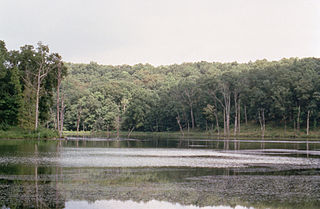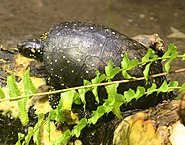 Those of us who are accustomed to seeing Eastern Painted Turtles (Chrysemys scripta scripta) in the wild and captivity sometimes take their beauty for granted. In my youth, I was able to find them quite easily near my Bronx home, and was surprised by the overseas demand when I began working for a local animal dealer. But upon close inspection, it’s easy to see why these aptly-named turtles are wildly-popular in zoos and private collections worldwide. In addition to their brilliant coloration, Eastern Painted Turtles make hardy, long-lived and responsive pets (if given proper care!). They have all the qualities that have made Red-Eared Sliders so popular, but their smaller size and calm demeanor renders them a far better choice for most turtle enthusiasts.
Those of us who are accustomed to seeing Eastern Painted Turtles (Chrysemys scripta scripta) in the wild and captivity sometimes take their beauty for granted. In my youth, I was able to find them quite easily near my Bronx home, and was surprised by the overseas demand when I began working for a local animal dealer. But upon close inspection, it’s easy to see why these aptly-named turtles are wildly-popular in zoos and private collections worldwide. In addition to their brilliant coloration, Eastern Painted Turtles make hardy, long-lived and responsive pets (if given proper care!). They have all the qualities that have made Red-Eared Sliders so popular, but their smaller size and calm demeanor renders them a far better choice for most turtle enthusiasts.
The Eastern Painted Turtle’s range extends from southern Canada along the eastern seaboard of the USA to Georgia, and west to central Alabama. Three subspecies – the Southern, Midland and Western Painted Turtles – range across southern Canada and through most of the USA to northern Mexico. All hybridize where their ranges overlap, and in captivity.
Painted Turtles favor slow-moving, well-vegetated waters, and are most commonly encountered in swamps, marshes, river oxbows, creeks, and small ponds on farms and even golf courses (I caught my first specimen, as a child, by hopping a golf course fence and sloshing through its tiny pond – that incident remains my only golf-related experience!). I once was surprised to find a hatchling in a tidal river on Long Island, but have since learned that they are known to enter brackish water.
Turtle Behavior in Captivity
Like many semi-aquatic turtles, Eastern Painteds quickly learn to associate their owners with food, and will paddle over to beg when you approach. Ever-alert, wild individuals plunge from basking sites when startled, but pets are generally quite fearless. Most feed readily from the hand, and they may even reproduce.
Housing
Female Eastern Painted Turtles reach 7-9 inches in length, while males generally top out at 5 inches. An adult female will require a 30 to (preferably) 40 or 55 gallon aquarium; a male might make due in a 20 gallon “long-style”, but more room is preferable.
Zoo Med’s Turtle Tub is an excellent option for larger individuals. Plastic storage bins, if properly outfitted, may also be used.
Wading pools are often easier to manage than aquariums. Koi ponds sometimes contain shelves meant to hold plants; these work well as turtle basking areas. Outdoor housing is ideal, assuming that raccoons and other predators can be excluded.
Although highly aquatic, Painted Turtles need a dry surface on which to bask. Commercial turtle docks will suffice for smaller specimens. Cork bark, wedged or affixed via silicone to the aquarium’s sides, is a good option for adults.
Filtration
Turtles are messy feeders and very hard on water quality. Submersible or canister filters are necessary unless the enclosure can be emptied and cleaned several times weekly (I’ve found the Zoo Med Turtle Clean Filter to be ideal). Even with filtration, partial water changes are essential.
Removing your turtles to an easily-cleaned container for feeding will lessen the filter’s workload and help to keep the water clear.
Substrate
Bare-bottomed aquariums are best, as gravel traps food and wastes, greatly complicating cleaning. If gravel is used, it should be of a size too large to be swallowed.
Light
Heliothermic turtles (those that bask) require UVB exposure in captivity. Natural sunlight is the best UVB source, but be aware that glass filters-out UVB rays.
If a florescent bulb is used (the Zoo Med 10.0 Bulb is an excellent product), be sure that the turtle can bask within 6-12 inches of it. Mercury vapor bulbs broadcast UVB over greater distances, and also provide beneficial UVA radiation.
Heat
Water temperatures of 75-80 F should be maintained. An incandescent bulb should be used to warm the basking site to 88-90 F.
Companions
Painted turtles will eat or harass fishes, newts and aquatic frogs.
Individuals of the same sex may get along, but aggression often develops so be prepared to house them separately. It’s difficult to keep pairs together long-term, as the males’ continual mating attempts usually lead to stress and bite wounds.
Feeding
Painted Turtles begin life as carnivores but increasingly consume aquatic plants as they mature. Pets favor animal-based foods, but should be encouraged to eat plants; a fasting period will tempt them to sample new items.
Dandelion, kale, mustard and collared greens, romaine and other produce should be offered. Aquatic plants such as Elodea, Anachris and Duckweed may also be accepted. Spinach and beet leaves are high in oxalic acid and have been implicated in health problems.
 Zoo Med Aquatic Turtle Food and Reptomin Food Sticks provide excellent nutrition and can serve as 50-75% of the diet. Other commercial aquatic turtle diets and treats are also worth investigating.
Zoo Med Aquatic Turtle Food and Reptomin Food Sticks provide excellent nutrition and can serve as 50-75% of the diet. Other commercial aquatic turtle diets and treats are also worth investigating.
Natural foods should always be included in turtle diets. Whole freshwater fishes such as minnows and shiners are the best source of calcium for turtles. Offer fish at least once weekly, but use goldfishes sparingly as a steady goldfish diet has been implicated in liver ailments in other species.
Other important food items include earthworms, krill, freeze-dried river shrimp and crickets, waxworms and other insects.
Breeding
Wild females become sexually mature at age 5-10, males at age 3-5. Courting and breeding occurs in May and June, and females deposit 1-4 clutches of eggs (1-15 eggs in total) between May and July. Late-hatching young may overwinter in the nest and emerge the following spring.
Captive conditions may alter all of the above, so please write in for detailed information on how best to breed your pets in their particular environment.
Health Considerations
Salmonella bacteria, commonly present in turtle digestive tracts, can cause severe illnesses in people. Handling an animal will not cause an infection, as the bacteria must be ingested. Salmonella infections are easy to avoid via the use of proper hygiene. Wash your hands with warm, soapy water after handling any animal. Please speak with your family doctor concerning details, and feel free to write me for links to useful resources.
Further Reading
 That Reptile Blog – Reptile, Amphibian and Exotic Pet Care and Information
That Reptile Blog – Reptile, Amphibian and Exotic Pet Care and Information























